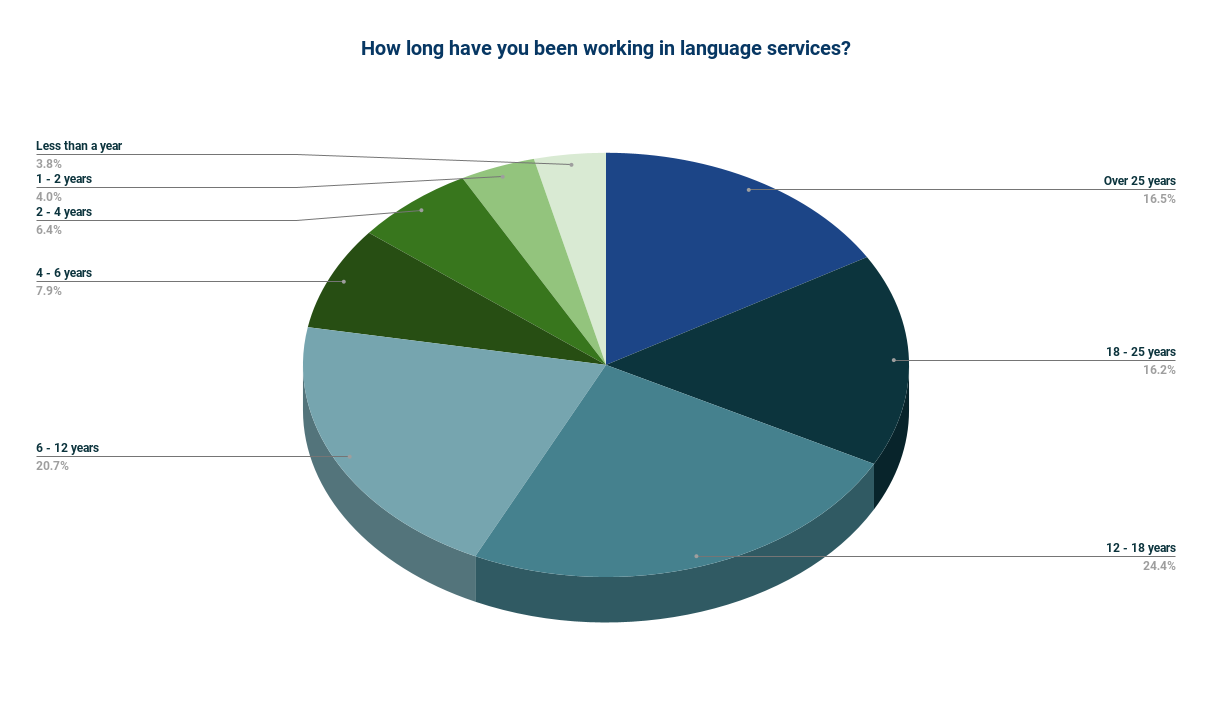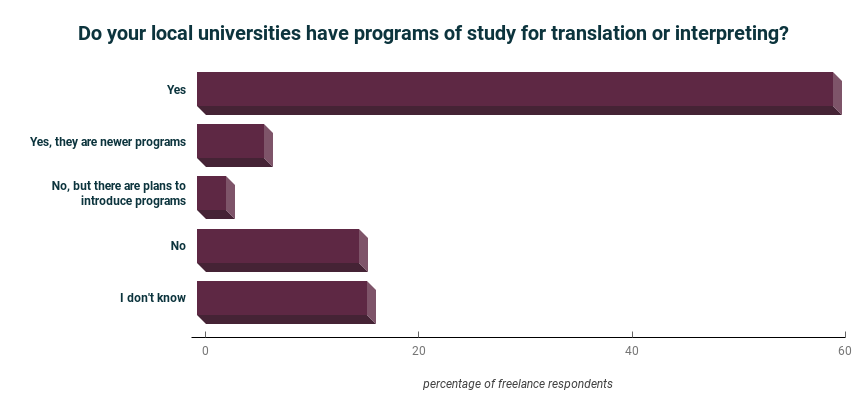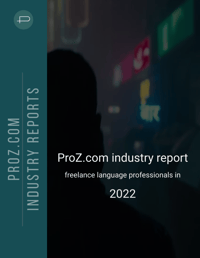Years in the industry

Education
Regardless of ups and downs in language services-related studies, there are not fewer people becoming translators and interpreters; as we saw earlier in this report, it is probably quite the opposite.
The barrier to entry for the language services industry has always been relatively low. A reasonably intelligent and independent person could, with not much of an investment up front, start translating, gain experience, and kick off their career. Compare this with other lines of work where traditionally the lack of a degree is a non-starter, regardless of your experience or talent.
Now, obviously someone who studies the line of work before going into it will start off their career with certain advantages. But fortunately for the language industry, that’s not the only way in. And it should be clarified for those not in the know that translators and interpreters in general are a highly-educated group; diversely so.
A doctor, lawyer, engineer, any professional with a propensity or talent for languages, can, comparatively easily, pick up the skills and know-how to launch a career in language services, with the added benefit of already having at least one area of specialization where they are intimately familiar with the terms, structures, and language used in that field.
So while the number of professionals coming into the industry directly from translation or interpreting studies may or may not be on the decline, the number of language professionals who have certification or degrees which strengthen the services they offer in their fields remains strong.
As of 2022, 50% of freelance language professionals report degrees in translation or interpreting studies. Upwards of 60% report degrees or certification in areas of study other than translation and interpreting. Between 50 and 55% hold degrees beyond an undergraduate-level degree (e.g. Masters or Doctorates).

.png)
Digital natives vs. digital immigrants
There is a bit of contention around the terms “digital native” and “digital immigrant.” In general, a “digital native” is a person who was born and raised in the digital age, while a “digital immigrant” is usually someone who learned to use computers and other technology at a later stage in life (i.e. if you are Gen X or before that, you are probably a digital immigrant). Even more care should probably be taken when trying to apply them to freelance language professionals. But as a fun data point that gives an indicator of age, roughly 25% of freelance language professionals would consider themselves digital natives.
Why does this mean relatively little, beyond an indication of when one was born, in this particular industry? Freelance language professionals today, in general, due to the nature of their work, are above average in digital, computer, and internet competence, so the supposed differences between the two groupings tend to flatten out more here than they might in other contexts. There are even some arguments that those who are “digital immigrants” have had to develop a more detailed understanding of some software and other tools, as well as having learned certain non-digital strategies, which they are able to use to their advantage in their digital work lives.
Households
.png)
Languages spoken
Housing and mobility
Just over 19% of language professionals have changed their place of residence in the past two years; 6% of them moved from one country to another.
Have languages, will travel. Beyond place of residence, around 34% self-identify as what some call “digital nomads” and spend a good portion of their time working while traveling. If you are socially networking with other freelancers you probably know some, or have seen their pictures and locations pop up in your feed: tasting different local cuisines, translating from Indonesia this month, from South America the next. What, he’s in Dubai now? With the right roster of clients and the right amount of organization and self-discipline, it is a lifestyle that is possible for a freelance language professional, and a much more difficult situation to achieve from other lines of work.
Main earners
-
56% say they are the main breadwinner in their household. This percentage is up roughly 10% from ten years ago.
-
43% say that more than 80% of their household's income comes from their freelance work.
-
22% say it’s about a 50-50 split between them and their partner.
37% say that they are the sole breadwinner of their household, but at the same time, around 23% report that they are the only person in their household, too.
This is an excerpt of the most recent ProZ.com industry report. To read the full report, you can go to https://www.proz.com/industry-report/
ProZ.com industry reports are periodic publications that take a look at trends, challenges, and opportunities in the language services industry, from the perspective of the freelance language professional. ProZ.com paying members enjoy immediate, full access to these reports.
Next up: Income, planning and investments among freelancers. And now that I've written the word "investments", you're probably reading this because you're serious about what you do, and serious professionals also invest in their business and work. ProZ.com membership is an investment no-brainer when it comes to working as a freelance language professional. On average, ProZ.com members in 2022 turned their membership fees into over 4,000 USD in immediate returns in the form of work received, and a potential lifetime of returns that come from meeting new clients and establishing good relationships with them.
If you are not yet a ProZ.com member, you can start now, with special discounts on membership and training. Find out more »



